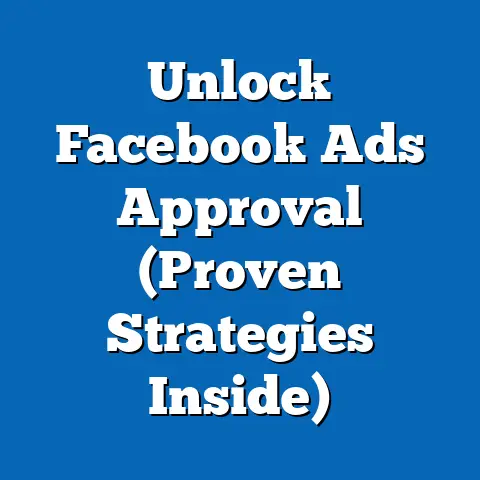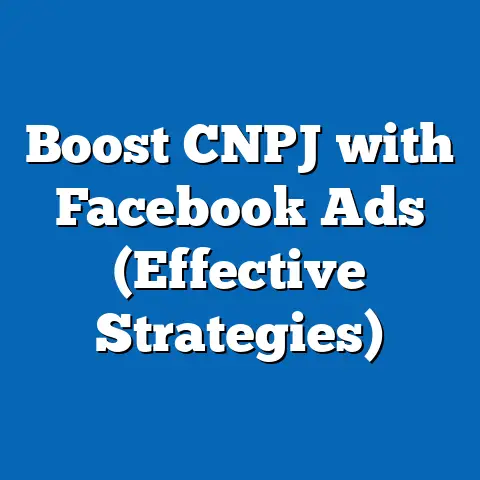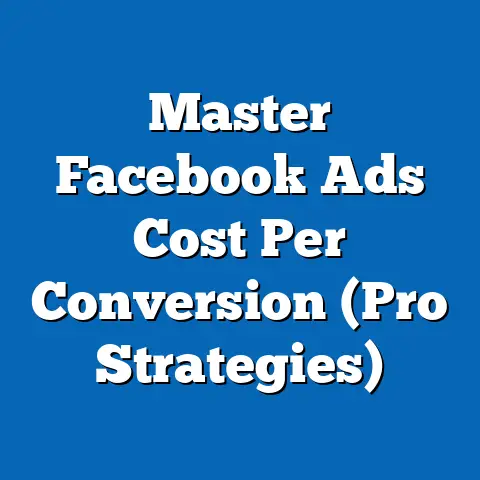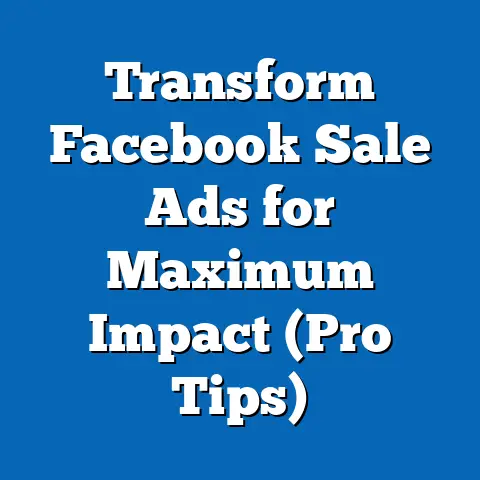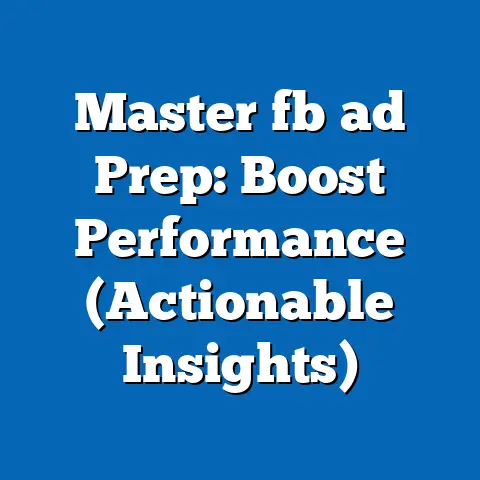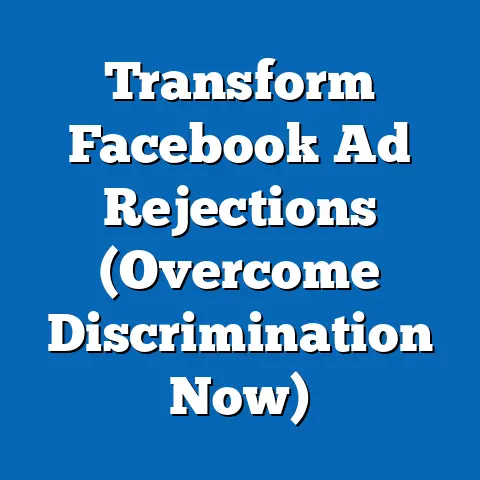Understand Facebook Advertisers (Essential Insights Revealed)
Facebook advertising. The very phrase conjures images of targeted campaigns, pixel-perfect visuals, and the ever-elusive promise of reaching millions. But behind the sleek interface and user-friendly tools lies a complex and dynamic world. It’s a world I’ve spent years navigating, learning the ins and outs, celebrating the wins, and, yes, weathering the occasional frustrating update. Think of it as a rich tapestry, woven with threads of creativity, data analysis, strategic planning, and audience engagement. Understanding these threads, feeling the “textures” of this platform, is crucial to truly master Facebook advertising.
This isn’t just about knowing how to click buttons in Ads Manager. It’s about understanding the why behind the how. It’s about stepping into the shoes of a successful Facebook advertiser and seeing the world through their eyes. It’s about appreciating the art and science that come together to create effective campaigns.
Section 1: The Fabric of Facebook Advertising
Let’s start with the very foundation: What is Facebook advertising?
Simply put, Facebook advertising is a paid marketing strategy that leverages the Facebook platform to reach a specific audience with targeted messages. It allows businesses to promote their products, services, or brand to Facebook’s massive user base, which, as of the latest data, boasts billions of active users. Think about that for a second – billions! That’s a potential reach unlike anything seen before in marketing history.
Why is it significant in the digital marketing ecosystem?
Facebook advertising’s significance stems from several key factors:
- Unparalleled Reach: As mentioned, Facebook’s massive user base provides access to a diverse and extensive audience.
- Granular Targeting: Facebook’s robust targeting options allow advertisers to reach specific demographics, interests, behaviors, and more.
- Measurable Results: Facebook provides detailed analytics and reporting tools, allowing advertisers to track campaign performance and optimize for ROI.
- Versatile Ad Formats: Facebook offers a variety of ad formats, catering to different marketing objectives and creative preferences.
- Cost-Effective Advertising: Compared to traditional advertising channels, Facebook advertising can be a cost-effective way to reach a large and targeted audience.
I remember when I first started experimenting with Facebook ads. I was amazed by the level of control I had over who saw my ads. I could target users based on their age, location, interests, even their relationship status! It felt like I had a laser pointer, capable of reaching exactly the right people with my message.
Exploring the Different Types of Facebook Ads
Facebook offers a diverse array of ad formats, each with its unique strengths and use cases. Understanding these formats is crucial for crafting effective campaigns. Let’s explore some of the most common types:
-
Image Ads: These are the simplest and most common type of Facebook ad, featuring a single image and accompanying text. They’re great for showcasing products, highlighting brand messaging, or driving traffic to a website.
-
Video Ads: Video ads are highly engaging and can be used to tell stories, demonstrate products, or capture attention in a visually appealing way. They can be used in-feed, in-stream, or as Stories ads.
-
Carousel Ads: Carousel ads allow advertisers to showcase multiple images or videos in a single ad unit. This format is ideal for highlighting different features of a product, showcasing a collection of items, or telling a sequential story.
-
Slideshow Ads: Slideshow ads are similar to video ads but use a series of static images to create a dynamic visual experience. They’re a great option for advertisers who don’t have the resources to create video content.
-
Collection Ads: Collection ads are designed to drive product discovery and sales. They feature a main image or video along with a selection of related products that users can browse and purchase directly from the ad.
-
Lead Ads: Lead ads are designed to collect leads directly from Facebook. They feature a pre-filled form that users can submit with just a few taps, making it easy for advertisers to gather contact information and build their email list.
Image Ads: These are the simplest and most common type of Facebook ad, featuring a single image and accompanying text. They’re great for showcasing products, highlighting brand messaging, or driving traffic to a website.
Video Ads: Video ads are highly engaging and can be used to tell stories, demonstrate products, or capture attention in a visually appealing way. They can be used in-feed, in-stream, or as Stories ads.
Carousel Ads: Carousel ads allow advertisers to showcase multiple images or videos in a single ad unit. This format is ideal for highlighting different features of a product, showcasing a collection of items, or telling a sequential story.
Slideshow Ads: Slideshow ads are similar to video ads but use a series of static images to create a dynamic visual experience. They’re a great option for advertisers who don’t have the resources to create video content.
Collection Ads: Collection ads are designed to drive product discovery and sales. They feature a main image or video along with a selection of related products that users can browse and purchase directly from the ad.
Lead Ads: Lead ads are designed to collect leads directly from Facebook. They feature a pre-filled form that users can submit with just a few taps, making it easy for advertisers to gather contact information and build their email list.
Each of these ad types has a different “texture.” Image ads are straightforward and clean, while video ads are immersive and dynamic. Carousel ads offer a sense of exploration, and lead ads are all about efficiency. Choosing the right ad format is about understanding the “feel” you want to create and how it aligns with your marketing goals.
The Facebook Ads Manager: Your Command Center
The Facebook Ads Manager is the central hub for creating, managing, and analyzing your Facebook ad campaigns. It’s where you define your target audience, set your budget, design your ads, and track your results.
Key features of the Ads Manager include:
- Campaign Creation: A guided process for setting up new ad campaigns, defining your objectives, and selecting your target audience.
- Ad Set Management: Tools for managing ad sets, which are groups of ads that share the same targeting, budget, and schedule.
- Ad Creation: A user-friendly interface for designing and creating your ads, with options for choosing ad formats, uploading images or videos, and writing compelling ad copy.
- Reporting and Analytics: Comprehensive reporting tools that provide insights into campaign performance, allowing you to track key metrics and identify areas for improvement.
- A/B Testing: Features for running A/B tests, allowing you to compare different ad variations and optimize for better results.
I remember feeling completely overwhelmed when I first logged into the Ads Manager. There were so many options, settings, and features! But with time and practice, I learned to navigate the interface and appreciate its power. It’s like learning a new language – it takes effort, but the payoff is well worth it.
Statistics and Case Studies: Proof of the Pudding
Facebook advertising’s effectiveness is well-documented, with numerous statistics and case studies showcasing its impact on various industries.
- According to recent reports, Facebook ads can reach 2.11 billion people. (Source: Statista)
- The average click-through rate (CTR) for Facebook ads across all industries is around 0.9%. (Source: WordStream)
- A case study by HubSpot found that Facebook lead ads generated a 4x increase in leads compared to traditional methods.
These statistics and case studies demonstrate the potential of Facebook advertising to drive results for businesses of all sizes. However, it’s important to remember that success depends on a well-defined strategy, effective targeting, and compelling ad creative.
Key Takeaways for Section 1:
- Facebook advertising is a powerful tool for reaching a large and targeted audience.
- Understanding the different ad formats and their unique characteristics is crucial for crafting effective campaigns.
- The Facebook Ads Manager is the central hub for creating, managing, and analyzing your ad campaigns.
- Statistics and case studies demonstrate the potential of Facebook advertising to drive results, but success depends on a well-defined strategy.
Next Steps:
- Familiarize yourself with the different ad formats available on Facebook.
- Explore the Facebook Ads Manager and its key features.
- Research case studies and statistics that demonstrate the effectiveness of Facebook advertising in your industry.
Section 2: The Advertiser’s Palette: Targeting and Segmentation
Now that we’ve covered the basics of Facebook advertising, let’s dive into one of its most powerful features: targeting. Facebook’s robust targeting options allow advertisers to reach specific audiences with tailored messages, maximizing the effectiveness of their campaigns.
Demographic Targeting
Demographic targeting allows you to reach users based on their age, gender, location, education, job title, relationship status, and other demographic characteristics. This is a fundamental targeting option that can be used to narrow down your audience and ensure that your ads are seen by the right people.
For example, if you’re selling products targeted towards young adults, you can target users aged 18-25. If you’re promoting a local event, you can target users within a specific geographic area.
Interest-Based Targeting
Interest-based targeting allows you to reach users based on their interests, hobbies, and passions. Facebook gathers this information from users’ profiles, the pages they like, and the content they engage with.
This is a powerful way to reach users who are likely to be interested in your products or services. For example, if you’re selling fitness equipment, you can target users who are interested in fitness, health, or sports.
Behavioral Targeting
Behavioral targeting allows you to reach users based on their online behavior, such as their purchase history, browsing activity, and device usage. Facebook gathers this information from users’ activity on and off the platform.
This is a highly effective way to reach users who are likely to take a specific action, such as making a purchase or signing up for a newsletter. For example, if you’re selling e-commerce software, you can target users who have recently purchased similar software or who have visited websites related to e-commerce.
Custom Audiences
Custom Audiences allow you to target your existing customers or website visitors on Facebook. You can create Custom Audiences by uploading a list of email addresses or phone numbers, or by using the Facebook pixel to track website visitors.
This is a great way to re-engage your existing customers, promote new products to your loyal fans, or target users who have shown interest in your brand but haven’t yet made a purchase.
Lookalike Audiences
Lookalike Audiences allow you to reach new users who are similar to your existing customers or website visitors. Facebook analyzes the characteristics of your Custom Audience and identifies other users who share similar traits.
This is a powerful way to expand your reach and find new customers who are likely to be interested in your products or services.
Detailed Targeting
Detailed Targeting allows you to combine multiple targeting options to create highly specific audiences. You can layer demographic, interest-based, and behavioral targeting options to reach users who meet a specific set of criteria.
This is a great way to fine-tune your targeting and ensure that your ads are seen by the most relevant audience.
The “texture” of each targeting option is different. Demographic targeting provides a broad, foundational layer. Interest-based targeting adds a layer of personal connection. Behavioral targeting taps into users’ actions and intentions. Custom and Lookalike Audiences leverage your existing data to create highly targeted segments.
Understanding Audience Motivations and Behaviors
Effective audience segmentation goes beyond simply identifying demographic characteristics or interests. It requires a deep understanding of your audience’s motivations, needs, and behaviors.
- What are their pain points? What problems are they trying to solve?
- What are their aspirations? What goals are they trying to achieve?
- What motivates their purchasing decisions? What factors influence their choices?
- What are their preferred communication channels? Where do they spend their time online?
By understanding these factors, you can craft ad messages that resonate with your audience on a deeper level and drive better results.
I once worked on a campaign for a travel agency that specialized in adventure tours. Instead of simply targeting users interested in “travel,” we delved deeper into their motivations. We identified users who were interested in “extreme sports,” “outdoor adventures,” and “challenging themselves.” We then crafted ad messages that spoke to their desire for excitement and new experiences, resulting in a significant increase in bookings.
Examples of Successful Targeting Strategies
- A local restaurant targeting users within a 5-mile radius who are interested in “food,” “restaurants,” and “local businesses.” This ensures that their ads are seen by people who are likely to visit their restaurant.
- An e-commerce store selling baby products targeting new parents or expecting parents. This allows them to reach users who are actively looking for baby products.
- A software company targeting business owners or marketing professionals who are interested in “marketing,” “sales,” or “technology.” This ensures that their ads are seen by people who are likely to use their software.
Key Takeaways for Section 2:
- Facebook offers a wide range of targeting options, allowing you to reach specific audiences with tailored messages.
- Understanding your audience’s motivations and behaviors is crucial for effective audience segmentation.
- Combining multiple targeting options can help you create highly specific audiences.
- Custom Audiences and Lookalike Audiences are powerful tools for re-engaging existing customers and finding new ones.
Next Steps:
- Research your target audience and identify their key demographic characteristics, interests, and behaviors.
- Experiment with different targeting options in the Facebook Ads Manager.
- Create Custom Audiences based on your existing customer data.
- Use Lookalike Audiences to expand your reach and find new customers.
Section 3: Crafting Compelling Ads: The Art of Creativity
Now that we’ve defined our target audience, it’s time to focus on the art of crafting compelling ads. This is where creativity comes into play, and where you can truly make your ads stand out from the crowd.
Visual Elements
Visual elements are the first thing that users see when they encounter your ad. They play a crucial role in capturing attention and conveying your message.
- Images: Use high-quality, visually appealing images that are relevant to your product or service.
- Videos: Videos are highly engaging and can be used to tell stories, demonstrate products, or capture attention in a visually appealing way.
- Graphics: Use graphics to highlight key features, showcase data, or add visual interest to your ad.
Copywriting
Your ad copy is the text that accompanies your visual elements. It should be clear, concise, and compelling, and it should clearly communicate the value proposition of your product or service.
- Headline: Your headline is the first thing that users will read. It should be attention-grabbing and clearly communicate the main benefit of your product or service.
- Description: Your description should provide more detail about your product or service and explain why users should take action.
- Call to Action: Your call to action (CTA) tells users what you want them to do next, such as “Shop Now,” “Learn More,” or “Sign Up.”
Branding
Your branding is the visual identity of your company. It should be consistent across all of your ads and marketing materials.
- Logo: Include your logo in your ads to build brand recognition.
- Colors: Use your brand colors in your ads to create a cohesive visual identity.
- Typography: Use your brand fonts in your ads to maintain consistency.
The “texture” of your ad is heavily influenced by these elements. A clean, minimalist image and concise copy create a feeling of sophistication. A bold, colorful video and energetic copy convey excitement and enthusiasm. Your branding should be woven throughout, creating a consistent and recognizable experience.
The Importance of Storytelling
Storytelling is a powerful tool for connecting with your audience on an emotional level. By telling a story in your ads, you can capture attention, build rapport, and create a lasting impression.
- Identify your target audience’s pain points and aspirations. What challenges are they facing? What goals are they trying to achieve?
- Craft a story that resonates with their experiences. Show them how your product or service can help them overcome their challenges or achieve their goals.
- Use compelling visuals and language to bring your story to life. Create a vivid and memorable experience for your audience.
I once worked on a campaign for a non-profit organization that provided clean water to communities in developing countries. Instead of simply showing statistics about water scarcity, we told the story of a young girl who had to walk miles each day to collect water for her family. The ad resonated deeply with viewers, and we saw a significant increase in donations.
Analyzing the Textures of Effective Ad Design
- Color Psychology: Colors evoke different emotions and can influence user behavior. Use colors strategically to create the desired mood and message. For example, blue can convey trust and reliability, while red can convey excitement and energy.
- Typography: Choose fonts that are easy to read and that reflect your brand’s personality. Use different font sizes and styles to create visual hierarchy and highlight key information.
- Imagery: Use high-quality images that are relevant to your product or service and that capture the attention of your target audience. Avoid using stock photos that look generic or inauthentic.
- Layout: Create a clear and visually appealing layout that guides the user’s eye through the ad. Use white space to create breathing room and avoid cluttering the ad with too much information.
A/B Testing: Refining Your Creative Approach
A/B testing is a powerful tool for optimizing your ad creative. It allows you to compare different ad variations and see which ones perform best.
- Test different headlines, descriptions, and CTAs. See which ones resonate most with your target audience.
- Test different images and videos. See which ones capture the most attention and drive the most engagement.
- Test different targeting options. See which audiences are most responsive to your ads.
By continuously A/B testing your ads, you can refine your creative approach and improve your campaign performance.
Key Takeaways for Section 3:
- Visual elements, copywriting, and branding are all crucial components of effective ad creative.
- Storytelling is a powerful tool for connecting with your audience on an emotional level.
- Understanding the principles of color psychology, typography, imagery, and layout can help you create visually appealing ads.
- A/B testing is essential for optimizing your ad creative and improving your campaign performance.
Next Steps:
- Experiment with different visual elements, copywriting techniques, and branding strategies.
- Craft a compelling story that resonates with your target audience.
- Analyze the design of successful Facebook ads and identify the elements that make them effective.
- Use A/B testing to refine your creative approach and improve your campaign performance.
Section 4: Measuring Success: The Metrics That Matter
Creating compelling ads is only half the battle. To truly succeed with Facebook advertising, you need to track your results and measure your performance. This is where key performance indicators (KPIs) come into play.
Key Performance Indicators (KPIs) for Facebook Advertisers
- Click-Through Rate (CTR): CTR measures the percentage of users who see your ad and click on it. A high CTR indicates that your ad is relevant and engaging to your target audience.
- Cost Per Click (CPC): CPC measures the average cost you pay each time someone clicks on your ad. A low CPC indicates that your ad is cost-effective.
- Conversion Rate: Conversion rate measures the percentage of users who click on your ad and then take a desired action, such as making a purchase or signing up for a newsletter. A high conversion rate indicates that your ad is effective at driving results.
- Return on Ad Spend (ROAS): ROAS measures the amount of revenue you generate for every dollar you spend on advertising. A high ROAS indicates that your ad campaign is profitable.
Each of these metrics has its own “texture.” CTR reflects the initial appeal of your ad. CPC reveals the efficiency of your targeting and bidding strategy. Conversion rate showcases the effectiveness of your landing page and overall sales funnel. ROAS provides a clear picture of your campaign’s profitability.
Tracking and Analyzing Ad Performance
Facebook provides a variety of tools for tracking and analyzing your ad performance.
- Facebook Analytics: Facebook Analytics provides detailed insights into user behavior on your website or app. You can use it to track conversions, measure engagement, and understand how users are interacting with your content.
- Facebook Ads Manager: The Facebook Ads Manager provides comprehensive reporting tools that allow you to track key metrics, analyze campaign performance, and identify areas for improvement.
- Third-Party Tools: There are also a variety of third-party tools that can help you track and analyze your ad performance, such as Google Analytics, HubSpot, and Kissmetrics.
Data-Driven Decisions: Adjusting Your Strategies
The key to successful Facebook advertising is to use data to inform your decisions. By tracking your KPIs and analyzing your ad performance, you can identify areas for improvement and adjust your strategies accordingly.
- If your CTR is low, try improving your ad creative. Experiment with different headlines, descriptions, images, and videos.
- If your CPC is high, try refining your targeting options. Narrow down your audience to reach users who are more likely to be interested in your product or service.
- If your conversion rate is low, try optimizing your landing page. Make sure your landing page is relevant to your ad, easy to navigate, and includes a clear call to action.
- If your ROAS is low, try adjusting your budget or bidding strategy. Allocate more budget to your best-performing ads and reduce spend on underperforming ads.
I remember when I first started tracking my ad performance. I was surprised to see how much my results varied depending on the time of day, the day of the week, and the device that users were using. By analyzing this data, I was able to optimize my campaigns and significantly improve my ROI.
Case Studies: The Impact of Data-Driven Decisions
- A case study by WordStream found that businesses that track their Facebook ad performance see a 2x increase in ROI compared to businesses that don’t.
- A case study by HubSpot found that businesses that use Facebook Analytics to track user behavior see a 3x increase in conversions.
These case studies demonstrate the power of data-driven decision-making. By tracking your KPIs and analyzing your ad performance, you can identify areas for improvement and significantly improve your campaign results.
Key Takeaways for Section 4:
- Key performance indicators (KPIs) are essential for measuring the success of your Facebook ad campaigns.
- Tracking and analyzing your ad performance allows you to identify areas for improvement and optimize your strategies.
- Data-driven decisions are crucial for maximizing your ROI and achieving your advertising goals.
- Facebook Analytics, Facebook Ads Manager, and third-party tools can help you track and analyze your ad performance.
Next Steps:
- Set up tracking for your Facebook ad campaigns using Facebook Analytics and the Facebook Ads Manager.
- Track your KPIs on a regular basis and analyze your ad performance.
- Use data to inform your decisions and adjust your strategies accordingly.
- Research case studies that demonstrate the impact of data-driven decision-making on Facebook ad campaigns.
Section 5: Navigating Challenges: Common Pitfalls and Solutions
Facebook advertising can be a powerful tool, but it’s not without its challenges. Understanding these challenges and knowing how to overcome them is essential for long-term success.
Common Challenges Faced by Facebook Advertisers
- Ad Fatigue: Ad fatigue occurs when users start to get tired of seeing the same ads over and over again. This can lead to a decrease in CTR and conversion rates.
- Policy Compliance: Facebook has strict advertising policies that advertisers must adhere to. Violating these policies can result in your ads being disapproved or your account being suspended.
- Competition: The Facebook advertising landscape is highly competitive, with numerous businesses vying for the attention of the same audience.
- Algorithm Changes: Facebook’s algorithm is constantly changing, which can impact the performance of your ad campaigns.
These challenges each have their own unique “texture.” Ad fatigue feels like running in place, constantly trying to refresh your creative. Policy compliance feels like navigating a legal minefield. Competition feels like shouting into a crowded room. Algorithm changes feel like the ground shifting beneath your feet.
Staying Updated on Best Practices
The Facebook advertising landscape is constantly evolving, so it’s important to stay updated on the latest best practices.
- Follow industry blogs and publications. There are numerous blogs and publications that cover Facebook advertising, such as Social Media Examiner, AdEspresso, and Marketing Land.
- Attend industry events and webinars. Industry events and webinars are a great way to learn from experts and network with other advertisers.
- Join online communities and forums. Online communities and forums provide a platform for advertisers to share tips, ask questions, and learn from each other.
- Experiment with new features and strategies. Don’t be afraid to experiment with new features and strategies to see what works best for your business.
Insights from Advertisers Who Have Overcome Challenges
I’ve heard countless stories from advertisers who have faced seemingly insurmountable challenges and emerged victorious. Here are a few key insights I’ve gleaned:
- Embrace Adaptability: The only constant in Facebook advertising is change. Be prepared to adapt your strategies and tactics as the platform evolves.
- Focus on Value: Provide value to your audience through your ads. Don’t just try to sell them something. Offer them helpful information, entertaining content, or exclusive deals.
- Build Relationships: Build relationships with your customers and fans on Facebook. Engage with them, respond to their comments, and create a sense of community.
- Never Give Up: Facebook advertising can be challenging, but it’s also incredibly rewarding. Don’t give up on your goals. Keep learning, keep experimenting, and keep improving.
Anecdotal Evidence and Testimonials
“I was struggling to get my Facebook ads to perform well, but after implementing some of the strategies I learned from industry blogs, I saw a significant increase in my ROI,” says Sarah, a small business owner.
“I used to be afraid of Facebook’s advertising policies, but after taking the time to understand them, I was able to create ads that were both effective and compliant,” says John, a marketing manager.
These testimonials demonstrate that overcoming challenges in Facebook advertising is possible with the right knowledge, strategies, and mindset.
Key Takeaways for Section 5:
- Ad fatigue, policy compliance, competition, and algorithm changes are common challenges faced by Facebook advertisers.
- Staying updated on best practices is essential for navigating these challenges.
- Embrace adaptability, focus on value, build relationships, and never give up.
- Learning from the experiences of other advertisers can provide valuable insights and inspiration.
Next Steps:
- Identify the challenges that you are currently facing in your Facebook advertising campaigns.
- Research strategies for overcoming these challenges.
- Implement these strategies and track your results.
- Join online communities and forums to connect with other advertisers and learn from their experiences.
Conclusion
We’ve covered a lot of ground in this guide, from the fundamental building blocks of Facebook advertising to the advanced strategies for optimizing your campaigns. We’ve explored the different ad formats, targeting options, and creative techniques that can help you reach your target audience and achieve your marketing goals. We’ve also discussed the importance of tracking your results, measuring your performance, and adapting your strategies based on data.
But the most important takeaway is this: understanding Facebook advertisers requires an appreciation of the intricate “textures” that make up the advertising landscape. It’s about understanding the art and science that come together to create effective campaigns. It’s about understanding the motivations, needs, and behaviors of your target audience. And it’s about understanding the ever-evolving dynamics of the Facebook platform.
By applying the insights gained in this guide, you can enhance your own advertising strategies, foster a deeper connection with your target audiences, and achieve greater success on Facebook.
Remember, Facebook advertising is not a one-size-fits-all solution. It requires experimentation, adaptation, and a willingness to learn and grow. But with the right knowledge, strategies, and mindset, you can unlock the full potential of Facebook advertising and achieve your business goals.
So, go forth and weave your own tapestry of success on Facebook! The world of Facebook advertising is waiting to be explored, and I hope this guide has given you the tools and insights you need to navigate it with confidence and achieve your advertising dreams.

